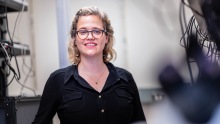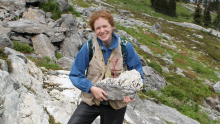UBC researchers have developed a DNA measurement platform that sets dramatic new performance standards in the sensitivity and accuracy of sample screening.
The advance could improve a range of genetic diagnostics and screenings where precise measurement is crucial--including the early detection of cancer, prenatal diagnostics, the detection of pathogens in food products, and the analysis of single cell gene expression.
The new digital polymerase chain reaction (PCR) device uses liquid surface tension, rather than systems of microscopic valves, to partition DNA samples into arrays of 1,000,000 chambers or more. The device enables the direct counting of single molecules isolated in individual chambers.
The density of reaction chambers achieved by the platform exceeds more traditional valve-based digital PCR techniques by a factor of 100, translating directly into improved performance.
"This solves some major technical issues that have limited the scale and accuracy of traditional digital PCR techniques," says Assistant Professor Carl Hansen with the UBC Department of Physics and Astronomy and Centre for High‐Throughput Biology. "It creates defect-free arrays of millions of uniform volume sub-reactions, and controls dehydration of these reactions during thermocycling."
PCR is an indispensable molecular biology technique used by researchers to amplify--or copy--a single piece of DNA millions or billions of times. The technique relies on repeated cycles of heating and cooling of the reaction to replicate segments of DNA using a protein called DNA polymerase, the same enzyme that copies DNA in living cells. PCR is used in medical and biology labs to clone DNA, analyze genes, detect hereditary disease, and in forensics.
The description of the 'megapixel' platform was published today in Nature Methods.
Digital PCR refers to a new generation of DNA replication techniques that offer increased sensitively and density over the original technique, developed in 1983. The greatest number of chambers available in commercially available implementations of digital PCR, using integrated micro-valves, is 36,960. However, further scalability is limited by the maximum density at which valves may be reliably fabricated.
Hansen believes the new version or digital PCR can be scaled to hold up to approximately 10,000,000 chambers on a standard one inch format.
The UBC researchers also found the new 'megapixel' technique set new benchmarks in detecting rare mutations--defined as the lowest measurable ratio of two target sequences differing by a single nucleotide variation as well as new limits in the detection of subtle differences in sequence abundance.
Partitioning of a one million chamber array takes approximately one minute.
"Our solution, or something using the same techniques, could enable a new degree of precision in measurements in biomedical research and diagnostics. The dramatic increase in assay density has important implications for the adoption of digital PCR as an economical, fast and routine analytical tool," says Hansen.
This research was funded by the Canadian Institute for Health Research, the Terry Fox Foundation, and the Natural Science and Engineering Research Council.
Megapixel Digital PCR
http://dx.doi.org/10.1038/nmeth.1640
Nature Methods
www.nature.com/nmeth
Musqueam First Nation land acknowledegement
We honour xwməθkwəy̓ əm (Musqueam) on whose ancestral, unceded territory UBC Vancouver is situated. UBC Science is committed to building meaningful relationships with Indigenous peoples so we can advance Reconciliation and ensure traditional ways of knowing enrich our teaching and research.
Learn more: Musqueam First Nation
Faculty of Science
Office of the Dean, Earth Sciences Building2178–2207 Main Mall
Vancouver, BC Canada
V6T 1Z4


